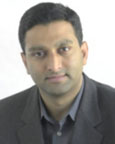August 03, 2005
Ramesh Raskar

Spatial Augmented Reality
The goal of Augmented Reality (AR) is to insert computer-generated virtual objects in the real world and the challenge is in creating an illusion of consistency between the real and the virtual environments. Traditional AR approaches involve head-mounted, eye-worn or hand-held displays. But we can draw parallels between the displays techniques used for virtual reality (VR) and AR, and speculate about the alternative approaches for AR.
In this talk--Friday, August 5th, 10am-12pm--Ramesh Raskar will discuss new practical alternatives using spatially augmented displays. The spatially augmented reality (SAR) approach exploits video projectors, cameras, radio frequency tags such as RFID, large optical elements, holograms and tracking technologies. The underlying techniques in SAR overcome some of the annoyances of the eye-worn AR in authoring, identification and image registration. He will discuss enabling techniques and describe our experience with applications in industrial maintanance, entertainment, art, education and various forms of human computer interactions.
Ramesh Raskar joined MERL as a Research Scientist in 2000 after his doctoral research at U. of North Carolina at Chapel Hill, where he developed a framework for projector based displays. His work spans a range of topics in computer vision and graphics including projective geometry, non-photorealistic rendering and intelligent user interfaces. Current projects include composite RFID (RFIG), multi-flash non-photorealistic camera for depth edge detection, locale-aware mobile projectors, high dynamic range video, image fusion for context enhancement and quadric transfer methods for multi-projector curved screen displays.
Dr. Raskar received the TR100 Award, Technology Review's 100 Top Young Innovators Under 35, 2004, Global Indus Technovator Award 2003, instituted at MIT to recognize the top 20 Indian technology innovators on the globe, Mitsubishi Electric Valuable Invention Award 2004 and Mitsubishi Electric Information Technology R&D Award 2003. He is a member of the ACM and IEEE. [via]
Posted by jo at August 3, 2005 10:18 AM
